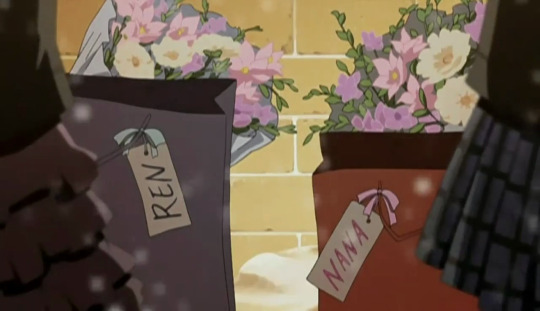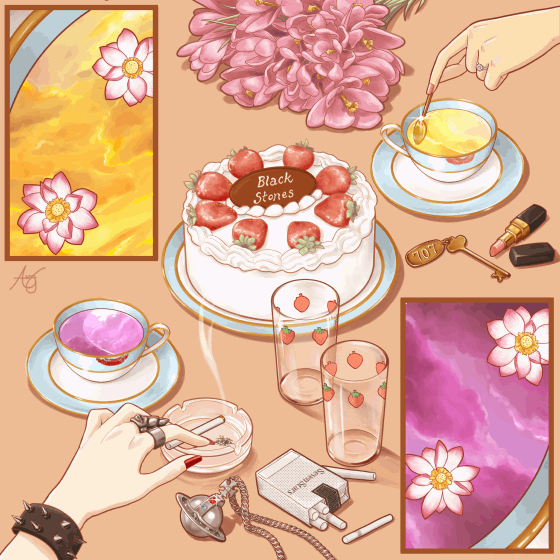Text
2021年8月3日[48/100]

Did a listening practice
Finished the 1st week in 総まとめn3文法
Revised vocabulary/kanji
25 notes
·
View notes
Text
2021年7月12日 [27/100]


Revised Kanji (Tobira)
studied grammar (~を問わず/~に限り/~つきに)
studied vocabulary (Mainly from Try n2)
11 notes
·
View notes
Text
Artblr
♥ I need the following blogs on my dash ♥
- artblr
- studyblr
- art history blogs
- langblr
- Japanese language blogs
- japanese fashion blogs
- japanese music blogs (rock, visual kei, jpop)
- aesthetics
Thank you!
#artblr#designblr#studyblr#art history#achitecture#academic#langblr#photography#japanese fashion#japanese food#inspirational#motivational#aesthetic#aesthetics#art#painting#drawing#traditonal art#watercolor#illustration#graphic design#contemporary art#performance art
69 notes
·
View notes
Text

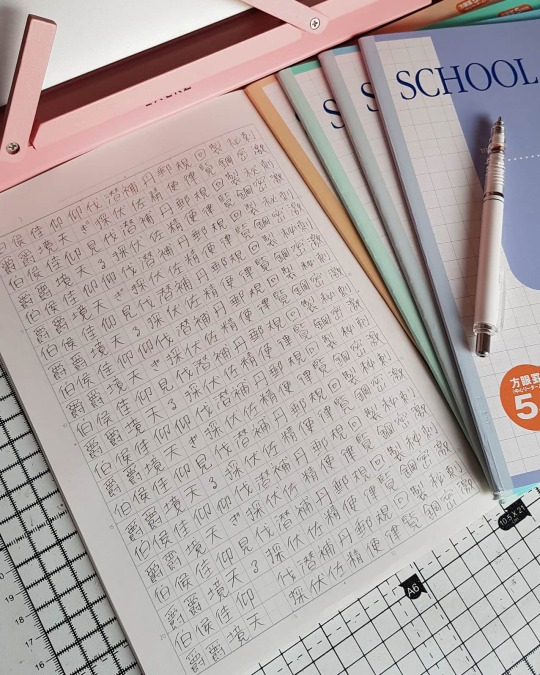
アマゾンで注文した漢字ドリル用ノートがやっと届きましたぁ!
Notebooks for kanji have finally arrived. Bought them from amazon : )
394 notes
·
View notes
Text




New books always gets me excited
152 notes
·
View notes
Text
My Japanese Notes Masterpost
Genki 1 Notes
*NOTE: Initially, I was posting lesson sheets and kanji sheets separately. After finishing the Lesson 3 sheets, I decided it was more efficient (and probably easier to find them) if I posted them together. This is why Lessons 1 through 3 have two post links. ごめんね!^_^;;
Lesson 1: lesson | kanji sheet
Lesson 2: lesson | kanji sheet
Lesson 3: here and here
Lesson 4
Lesson 5
Lesson 6
Lesson 7
Lesson 8
Lesson 9
Lessons 10 through 12 will be posted in the near future!
Grammar Notes
From Lingo Deer:
The Particle の
The Verb ある
The Verb いる
Other Notes:
Qualifying Nouns with Verbs and Adjectives (Relative Clauses)
みんな、日本語の勉強は頑張ろう!!難しいけど、諦めないで!

1K notes
·
View notes
Photo

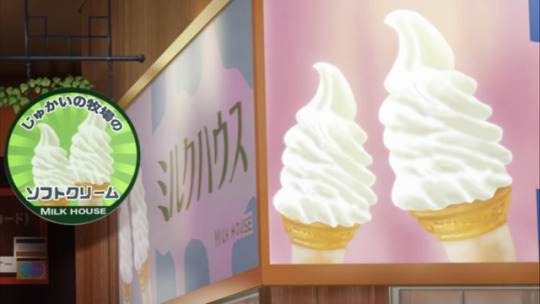
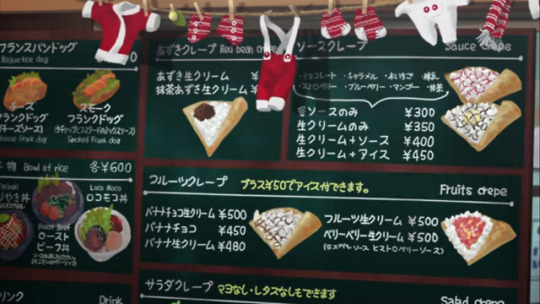
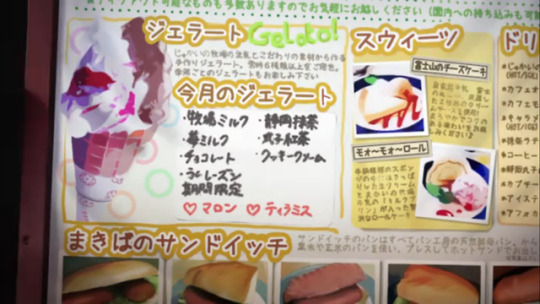
ソフトクリーム
じゅかい=n., sea of trees, abundant leafage
牧場=ぼくじょう (n., ranch, as in the landscape)
ソフトクリーム =soft-serve ice cream
ミルクハウス =Milk House (the name of the shop)
♡ Interesting Fact: Jukaino Bokujo (”Ranch in the Forest”) in the anime is based on Makaino Farm, which is an interactive farm with livestock, activities, play equipment, views of Mount Fuji & a restaurant.
あずきクレープ
Flavors
あずきクレープ = red bean (あずき) crepe
あずき生クリーム = red bean with whipped cream (なまクリーム)
抹茶あずさ生クリーム =matcha (まっちゃ), red bean, and whipped cream
ソースクレープ
ソースクレープ = sauce crepe (a crepe with just whipped cream and fruit sauce on top)
Flavors
チョコレート =chocolate
キャラメル =caramel
木いちご =きいちご (raspberry)
ストロベリー =strawberry
プルーベリー =blueberry
マンゴー =mango
株茶 = まっちゃ (matcha)
Additions
各ソースのみ (¥300)= かくソースのみ (each sauce only; i.e. no whipped cream; 各=かく each;のみ=only)
生クリームのみ (¥350)=only whipped cream
生クリーム+ソース (¥400)=whipped cream + sauce
生クリーム+アイス (¥450)=whipped cream + ice cream
つルーツクレープ
フルーツクレープ = fruits crepe (a crepe with fresh fruits inside)
プラス¥50でアイス付できます。
プラス¥50 =additional 50 yen
付できます=つけできます (付ける + できます=can add)
アイス = an abbreviation of アイスクリーム
Flavors
バナナチョコ生クリーム (¥500)=banana + chocolate + whipped cream
バナナチョコ (¥450)=banana + chocolate
バナナ生クリーム (¥480)=banana + whipped cream
フルーツ生クリーム (¥500)=fruits + whipped cream
ベリーベリー生クリーム¥500=berry berry (two different kinds of sauce, see below) + whipped cream
ラズベリーソースとストロベリーソース
ラズベリーソース =raspberry sauce
と=and
ストロベリーソース = strawberry sauce
ジェラート (Gelato)
今月のジェラート (This month’s gelato; こんげつ means “this month”)
牧場ミルク =Ranch milk (gelato produced from the shop’s house-made milk)
〇 ミルク =milk
チョコレート =chocolate
ラムレーズン =rum raisin
期間限定 = きかんげんてい (n., limited time)
静岡抹茶 =しずおかまっちゃ (Shizuoka matcha)
〇 〇紅茶 =こうちゃ (black tea)
クッキークリーム= cookies and cream
マロン =melon
ティとラミス =tea and ramune
**Note: I can’t find the kanji characters in the screencap where the 〇 are! If anyone can help out, that would be great~♡
スウィーツ (Sweets)
富士山のチーズケーキ =ふじさんのチーズケーキ (Mt. Fuji Cheesecake)
モオ~モォ~ロール =Moo Moo Roll
51 notes
·
View notes
Text
お久しぶり!!(*´ω`)
皆さんお久しぶりです!!
長い時間にいなくてごめんなさい!!最近仕事とか忙しいからあまり時間ありません(´;ω;`)
でも、今からもっとActiveにできます!
皆さんも元気ですか???
I’m sorry I’ve been away for so long! I got busy with life. I hope you have all been well!
-まいか
10 notes
·
View notes
Text
Japanese Addresses
The structure of the Japanese address or 住所 (じゅうしょ) is different from addresses in most parts of the world. Only the main streets in the cities have names, and individual buildings may not have numbers. The order of the address is written opposite to most English-speaking addresses - the Japanese postal code comes first while the street number comes last.
Large cities like Tokyo and Osaka are divided into 区 (く) or wards.
区 are divided into 町 (ちょう) which are towns or neighborhoods.
町 are divided into 丁目 (ちょうめ) or districts.
丁目 are divided into 街区 (がいく) which are city blocks.
街区 then have separate 番号 (ばんごう) or building numbers.
The address for the Tokyo Metropolitan Oizumi Central Park is:
〒178-0061 東京都 練馬区 大泉学園町 9丁目4−3
The post code is 178-0061.
The city is Tokyo (東京都), read Tokyo-to, meaning the Metropolis of Tokyo.
The ward is Nerima-ku (練馬区).
The neighborhood is Ōizumigakuen-chō (大泉学園町).
The district is 9-chōme, the city block number is 4, and the numbered address is 3 (9丁目4−3).
However, addresses don’t always include all of these parts, especially in smaller towns, or even within Tokyo itself. For example, the address for the Mori Art Museum in Tokyo is:
〒106-6150 東京都 港区 六本木 6丁目10−1, 六本木ヒルズ森タワー, 53階
Here you will find the post code, the city (Tokyo-to), and the ward (Minato-ku) just as before, but there is no -町, just Roppongi (六本木) and then the address numbers (6丁目10−1) and the building name ( 六本木ヒルズ森タワー or Roppongi Hills Mori Tower) and floor (53-kai). Oftentimes, the 丁目 is dropped and the address numbers would simply read 6-10-1.
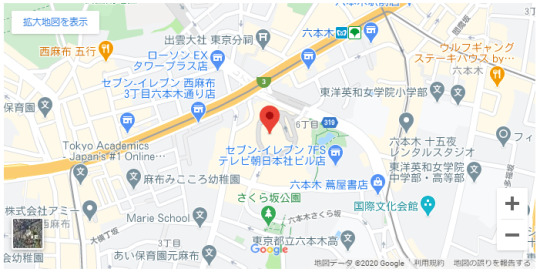
Note: When you address a letter to Japan (or even within Japan), addressing it in the Latin alphabet or ローマ字 is perfectly acceptable. It is also acceptable to address it in the Western format, with the street address first and the post code last. If you address it in the Japanese format, the name of the person to whom you are sending the post would be last, with their name followed by the formal honorific -sama (様).
342 notes
·
View notes
Text


05.22.21. Late night study corner.
19 notes
·
View notes
Note
Hi! So I'm learning the Thai Alphabet and I learned about Low Class Consonants, Middle Classes Consonants, and High Class Consonants. What's the difference between the different classes?
these classes are like an indicator of the tones and how the words will be pronounced.
(as shown below in the picture)
- middle class consonants
live syllable : can be used with all tones
dead syllable : can be used with low, falling, high, and rising tones
- high class consonants
live syllable : can be used with low, falling, and rising tones
dead syllable : can be used with low and falling tones
- low class consonants
live syllable : can be used with middle, falling, and high tones
dead syllable - short : can be used with falling and high tones
dead syllable - long : can be used with falling, high, and rising tones
ps. live syllables are words that end with consonants น ม ย ว ง and with long vowels, while dead syllables are those that end with consonants ก บ ด and with short vowels. however, there are also dead syllables that can end in long vowels so this made them part of the dead syllables - long group, while its counterparts that end in short vowels naturally are in dead syllables - short group.
ps no.2 in thai, there are 4 tonal symbols (excluding the middle tone because it doesn’t have any symbols) but sometimes, the words might not be pronounced as how they are indicated by the tonal symbols. for example, let’s look at the low class consonant. the falling tone’s symbol is ้. however, though the word น่า is pronounced in the falling tone, which the symbol should have actually been ้, the symbol presented in the word is ่. this is because of the consonants classes rules. (which will be too long to explain here and i personally cannot memorise all the rules myself to be honest)
ps no.3 the lass row that i erased is about ห นำ which i’m begging you not to learn about it right now because it’s one of the hardest things in the entire thai language me and my friends still don’t understand it oml
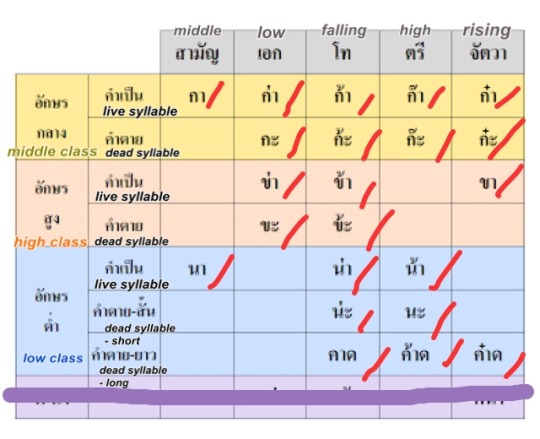
picture credits : https://sites.google.com/site/tiryangkhsrangkha/neux-hab-m-reiyn/kar-phan-xaksr-sam-hmu + edited by me to add the english translation asdfgjhfskha
61 notes
·
View notes
Text
Thai Vowels and Pronunciation Guide
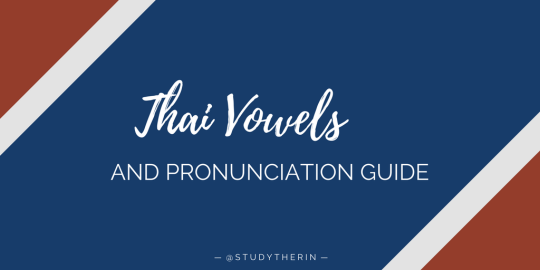
thai vowels have 21 symbols and 32 sounds (which on some sites might say we have 32 vowels) in thai, there are 18 short vowels and 14 long vowels. below here is a list of all vowels. the ones i group together have the similar sounds, it’s just that some are short vowels while some are long, if this makes any sense. it’s like the words “italy” and “we”. “i” in italy is short right there, while “e” in we is long. then try making the “i” in italy longer, yup, sound similar to “e” in “we” right? that’s how vowels work here.
ps. these may not be linguistically correct. but as a native, it’s the best explanation i can come up with. and it’s pretty challenging to break down one of the most basic things which we natives often neglect lol anyway, enjoy!
Keep reading
213 notes
·
View notes
Text
Thai Alphabet and Pronunciation Guide (Consonants)
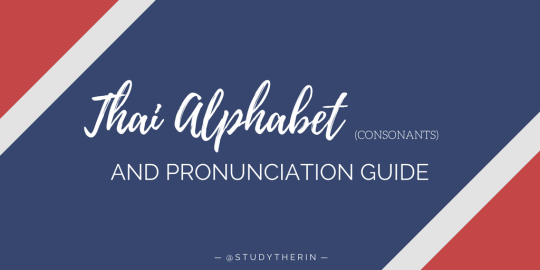
thai alphabet consists of 44 consonant letters, and 21 vowel symbols with 32 vowel sounds. here i’ve listed down the 44 consonants with their identical sounds in english. and the symbols in the parenthesis are their coordinate ipa.
ก (k) : gala, games, goat, garlic, gun
ข (kʰ) : car, cry, calm, kin, candy
ฃ (kʰ) : can, could, because, kind, coffee *obsolete*
ฅ (kʰ) : cold, crab, keen, cup, care *obsolete*
ค (kʰ) : come, colony, carry, keep, call
ฆ (kʰ) : command, clock, cake, key, climb
ง (ŋ) : thing, cling, strong, painting, bring
จ (tɕ) : jewellery, judge, joke, enjoy, just
ฉ (tɕʰ) : chew, show, shark, shallow, pressure
ช (tɕʰ) : sharp, shadow, cheese, shine, should
ซ (s) : sell, seal, someone, solo, sing
ฌ (tɕʰ) : choke, shake, shore, shall, shame
ญ (j) : yellow, yard, yarn, yes, yam
ฎ (d) : damp, dull, dream, dog, dark
ฏ (t) : similar to ㄸ in korean, d in chinese (弟弟、豆腐、大、打)
ฐ (tʰ) : team, teal, tan, tomb, tamarind
ฑ (tʰ) : total, torch, tool, tin, time
ฒ (tʰ) : tone, tear, teen, trade, tech
ณ (n) : know, now, need, no, night
ด (d) : don’t, dance, deal, door, doom
ต (t) : similar to ㄸ in korean, d in chinese (弟弟、豆腐、大、打)
ถ (tʰ) : tell, to, take, towel, tea
ท (tʰ) : trap, tower, troop, two, true
ธ (tʰ) : talk, try, toddler, tail, town
น (n) : never, new, nine, nanny, numb
บ (b) : about, break, brand, business, breathe
ป (p) : similar to ㅃ in korean, b in chinese (爸爸、笔、帮、拜)
ผ (pʰ) : pen, park, proud, play, plan
ฝ (f) : far, feel, fly, find, fin
พ (pʰ) : penny, power, paw, pebble, paper
ฟ (f) : for, fool, freedom, reflect, flower
ภ (pʰ) : people, party, pyjamas, place, pan
ม (m) : million, miles, me, more, moment
ย (j) : yank, you, yawn, year, youth
ร (r ) : the ร sound is neither american nor chinese r. it’s similar to the one in spanish, italian, russian, tagalog, etc.
ล (l) : love, alone, lay, lie, light
(do take note that in informal conversations, most thai drop the rolling r sound from ร and pronounce it as ล instead)
ว (w) : way, wind, wheel, whale, walk
ศ (s) : start, side, seem, reason, seat
ษ (s) : sun, sand, sky, sea, soul
ส (s) : secret, search, seven, safe, sit
ห (h) : heart, heat, heal, hike, hollow
ฬ (l) : life, lake, loop, lean, low
อ (ʔ) : even, always, apple, amber, army
ฮ (h) : how, hill, hand, hug, house
1K notes
·
View notes
Text
“November, the most beautiful month! Walking the streets, enveloped in a general lazy drizzle, shut off from the details around you, rendered impermeable, alone…”
— Mihail Sebastian, For Two Thousand Years (trans. Philip Ó Ceallaigh)
1K notes
·
View notes

